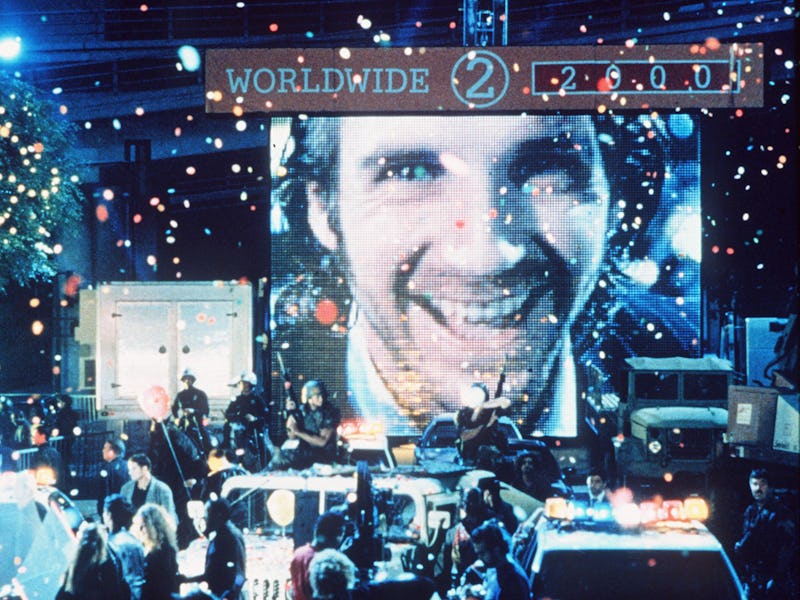30 Years Later, Strange Days Is Still Painfully Prescient
Kathryn Bigelow and James Cameron teamed up for an underrated sci-fi noir thriller that still rings true.

You slip a stocking over your head and check that your pistol’s loaded before bursting into the local Chinese restaurant and cleaning out the cash register, locking the staff into the freezer. As police cars approach the exit, you clamber onto the roof instead. In front of you, the chasm between buildings stretches out. Behind, the cops close in. You make the leap, then plummet horrifically to your demise. A second later, you jolt upright in the real world.
In Strange Days (1995), virtual reality tech live immerses users into not imagined scenarios, but lived recorded encounters, making it possible to vicariously experience crimes from the perpetrator’s POV. Kathryn Bigelow’s sci-fi noir thriller grounds this futuristic device in the sobering reality of assault on women and racially-motivated police brutality, while being prescient about our modern screen addiction. Twenty years after its release came “America’s first social media murder,” a double homicide in Roanoke, with live footage shot from their murderer’s perspective.
In the film, “wireheads” are hooked onto these snatches “of somebody’s life, pure and uncut,” as described by former LAPD cop Lenny Nero (Ralph Fiennes), now a black-market peddler of such recordings. He reacts viscerally to the Chinese restaurant robbery, but only because VR demises “bring down his day,” a nifty encapsulation of how putting oneself into other peoples’ viewpoints only leads to further dehumanization in a jaded, cynical world. Developed for police use, the cutting-edge technology is now used to fulfill the basest desires, from lurid sexual fantasies to violent felonies. The illicit aspect is the whole point, so visceral it’s almost tactile. It’s the thrill of crime without consequence.
The outside world is just as grim. Strange Days begins on December 20, 1999, the cusp of the new millennium, but the mood is that of deflation rather than elation. Gas is expensive. Schoolchildren are both perpetrators and shooting victims. Sporadic fires shroud the streets in smoke. A militarized police force shoves citizens against walls or into police cars. There are checkpoints everywhere. Even Santa gets mugged.
A delivered disc eventually shocks Lenny out of his stasis. Bigelow drops us into a sickening first-person POV of a rapist brutalizing prostitute Iris (Brigitte Bako) on tape. He’s modified their SQUIDs (Superconducting QUantum Interference Device), forcing her to watch herself being assaulted from his perspective virtually, even as she’s experiencing it in real life. The kinetic dynamism of the film’s opening action sequence — a taste of the device’s potential — gives way to pure revulsion at its weaponization.
Inspired by the Rodney King riots and the OJ Simpson trial, Strange Days shows that things haven’t changed much in the 30 years since its release.
Bigelow’s former husband James Cameron, who co-wrote the screenplay, was not only inspired by the voyeuristic interest in daytime TV shows but also a more morbid fascination with the OJ Simpson trial. SQUID’s virtual realities become a meta commentary on the act of movie-watching itself, in which people escape into another world temporarily, enthralled by the spectacle of violent action. Bigelow cements this through the staging of thrilling chase and combat sequences, making us complicit.
Along with hardscrabble driver Mace (Angela Bassett), Lenny discovers that Iris’ murder is linked to that of Black rapper Jeriko One (Glenn Plummer), known for his socially conscious anthems. Jeriko’s murder didn’t result from a gang shooting, as widely presumed — a furtive recording reveals he was racially harassed by two white cops who shot him to protect themselves when they realized the extent of his influence.
There are echoes of the high-profile Rodney King case here. In 1991, four cops arrested the LA resident for driving while intoxicated, brutally beating him. The assault was filmed by an amateur videographer and aired by a local TV station, drawing global attention and outrage. When the officers charged with using excessive force were acquitted a year later, six-day riots ravaged LA. “I was involved in the downtown cleanup, and I was very moved by that experience,” said Bigelow. “You got a palpable sense of the anger and frustration and economic disparity in which we live.” In Strange Days, that visceral public rage boils over. A group of officers begin battering Mace after stumbling onto her pointing a pistol at Jeriko’s murderers, whom she’s handcuffed in self-defense — how could a Black woman hope to explain these optics? The surrounding crowds charge to her defence, however, and mass rioting ensues.
At the very least, Strange Days offers us an optimistic ending.
Given its blistering condemnation of the police — Lenny begins investigating Iris’ murder himself, knowing the cops won’t care about a dead prostitute, likelier to turn her into a punchline — the optimistic swerve of the film’s ending appears naive in hindsight. In revealing that Jeriko’s murderers acted on their own, Bigelow fails to indict the US police force’s systemic rot and structural abuses of power. The police commissioner, initially dismissive of Mace and her illegal SQUID evidence, comes around and charges his subordinates with murder; that Black victims can expect such swift justice remains tragically unrealistic.
Then again, for all its horrors, Bigelow also taps into the hope technology offers, calling back to the King case videographer’s courageous use of it. In Strange Days, the SQUID experiences are shot in shaky handheld format too, similar to videos of modern crises filmed by everyday people on their phones.
Polarizing critics and failing to recoup even half of its $42-million budget upon release, the film remains a fascinating, deeply disturbing look at technology’s potential. It’s a relief that Bigelow chooses to end it on a snapshot of genuine human connection — a New Year’s countdown, confetti, a kiss.